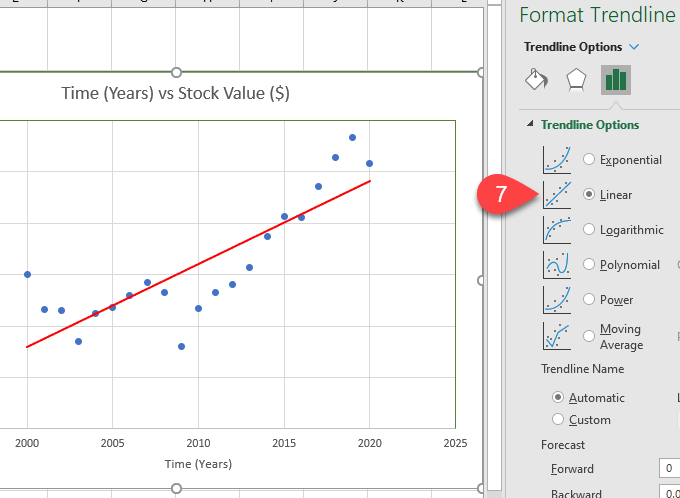
> Plugging the known numbers in to the formula, I am getting > 215B. > Roughly speaking, the result using September 30 end of > month (41182)as "x", I would expect this formula to > generate a "y" of greater than 33B and less than 34.5B. These are in date > format in Excel, but are whole numbers in formulas > (4112 respectively). "ottlots" wrote: > The "x"s in this case are dates at the end of the month: > Aug 31, 2012, September 30, 2012, etc.

Most likely the latter ("apply this wrong"). > The equation is: > y=5E+16e-3E-04x "ottlots" wrote: > I must have omitted some important details or I am > applying this wrong, because the results I am getting > don't make sense. > "ottlots" wrote previously: > I printed the trendline equation on the chart. In this case, it should be sufficient to create a new workbook,Ĭopy-and-paste the values for X and Y, then create the chart and the
#EXCEL TRENDLINE FOR SPECIFIC VALUES FREE#
The following is a list of some free file-sharing Then post the "shared", "public" or "view-only" link (aka URL in a response here. If you want more guidance, you can upload an example Excel file (devoid ofĪny private data) that demonstrates the problem to a file-sharing website. However, without the data (X and Y) used to generate the trendline, I cannot There is a better way to enter the coefficients into Excel: use LINEST in a > I am just trying to find the exact number the formula is > In the chart, the trendline follow the expected trajectory. I am just trying to find the exact number the formula is generating for subsequent months. In the chart, the trendline follow the expected trajectory. Plugging the known numbers in to the formula, I am getting 215B. Roughly speaking, the result using September 30 end of month (41182)as "x", I would expect this formula to generate a "y" of greater than 33B and less than 34.5B. The trend has been a more or less straight line decline from 37.7B in Dec 2011 to 34.5B in Aug 2012. These are in date format in Excel, but are whole numbers in formulas (4112 respectively). The "x"s in this case are dates at the end of the month: Aug 31, 2012, September 30, 2012, etc. Thanks - your explanation adds some clarity around E, but I must have omitted some important details or I am applying this wrong, because the results I am getting don't make sense. If you are interested in copying the trendline coefficients into an Excel formula, let us know, and we can offer proper instructions. There rounded values are usually too inaccurate to use into an Excel formula. However, it would be wrong to copy the trendline coefficients exactly as they are displayed. So if you were to write that in an Excel formula, ostensibly it would be: =(5E+16)*EXP(-(3E-04)*X1) I have over-parenthesized for clarity. Likewise 5E+16e is "5 times 10 to the power of 16, that times e to the power of.

Uppercase "E" is the Scientific notation for "10 to the power of". More precisely, it is EXP(1), where EXP() is an Excel function. My question is, what is the capital E? You are correct about the lowercase "e". I believe e is the math "e" > = 2.718 or so. I know what the > variables x and y mean. > The equation is: > y=5E+16e-3E-04x > The "-3E-04x" are in superscript. > "ottlots" wrote: > I printed the trendline equation on the chart. If you are interested in copying the trendline coefficients into an Excelįormula, let us know, and we can offer proper instructions.

There rounded values are usually too inaccurate to use However, it would be wrong to copy the trendline coefficients exactly as So if you were to write that in an Excel formula, ostensibly it would be: Likewise 5E+16e is "5 times 10 to the power of 16, that times e to the power I printed the trendline equation on the chart.


 0 kommentar(er)
0 kommentar(er)
